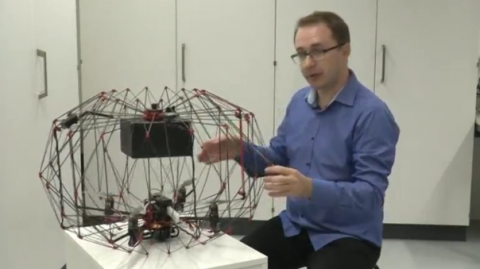
LAUSSANE, Switzerland (Reuters) — An origami-inspired prototype delivery drone which can transport packages to hard-to-reach destinations has been invented by a PhD student in Switzerland.
Przemyslaw Kornatowski’s drone in effect becomes the package by wrapping itself around the cargo before flight.
Made of carbon-fiber the cage, which can be folded or unfolded in a single movement, protects both drone and cargo if involved in a collision or fall.
“The cage provides safety because it separates the propellers from the user. Additionally there are safety switches, so whenever we open the cage the propellers are automatically turned off,” he said.
Recipients can catch the drone mid-flight without being injured by the propellers.
“We can get to places like collapsed buildings or where victims are trapped because we can just grab the whole drone during the flight. We are not hurt because the propellers are inside, so we can deliver directly to people’s hands in places not accessible to other drones.”
The drone can be flattened in seconds, cutting its volume by 92 percent, so it can be slipped inside a backpack.
A multicopter with four propellers, it can also take off and land vertically, increasing its accuracy.
Self-flying software programs deliveries, while a flight plan is created to ensure it avoids obstacles en route. The drone can be tracked in real time on a tablet or smartphone.
The drone can then return to base autonomously. Kornatowski says the UAV (unmanned aerial vehicle) contains a safety system that prevents it from being hacked.
“This drone at the moment can deliver half a kilo parcel for up to two kilometers, but we will work on improving the payload and the distance by optimizing the whole structure and reducing the weight,” he said.
Last summer the drone conducted more than 150 test flights, delivering items on the Ecole Polytechnique Federale de Lausanne campus.
It was designed in EPFL’s Laboratory of Intelligent Systems and received funding from Switzerland’s National Center of Competence in Research (NCCR) Robotics.
Companies like Amazon and Google continue to develop delivery drones, although some experts believe these make little economic sense because current prototypes usually carry a single package and have to fly back to a homebase before recharging and beginning another drop-off.







